Inclusive Urban Infrastructure: Sri Lanka Community Profiles
The CMRD Community Profiles display information about a broad range of factors from a specific location. The baseline information helps in researching, planning and analyzing material for studies that are in progress or development. The community data and illustrations are from both primary and secondary sources.
A listing of the six CMRD Community Profiles from the Inclusive Urban Infrastructure (IUI) project is below. IUI is a project funded by UK Research and Innovation through the Global Challenges Research Fund under the title ‘Towards Trajectories of Inclusion: Making infrastructure work for the most marginalised’ (grant reference number ES/T008067/1).
A Community Profile of Sarnia Estate
By: Sakeena Alikhan
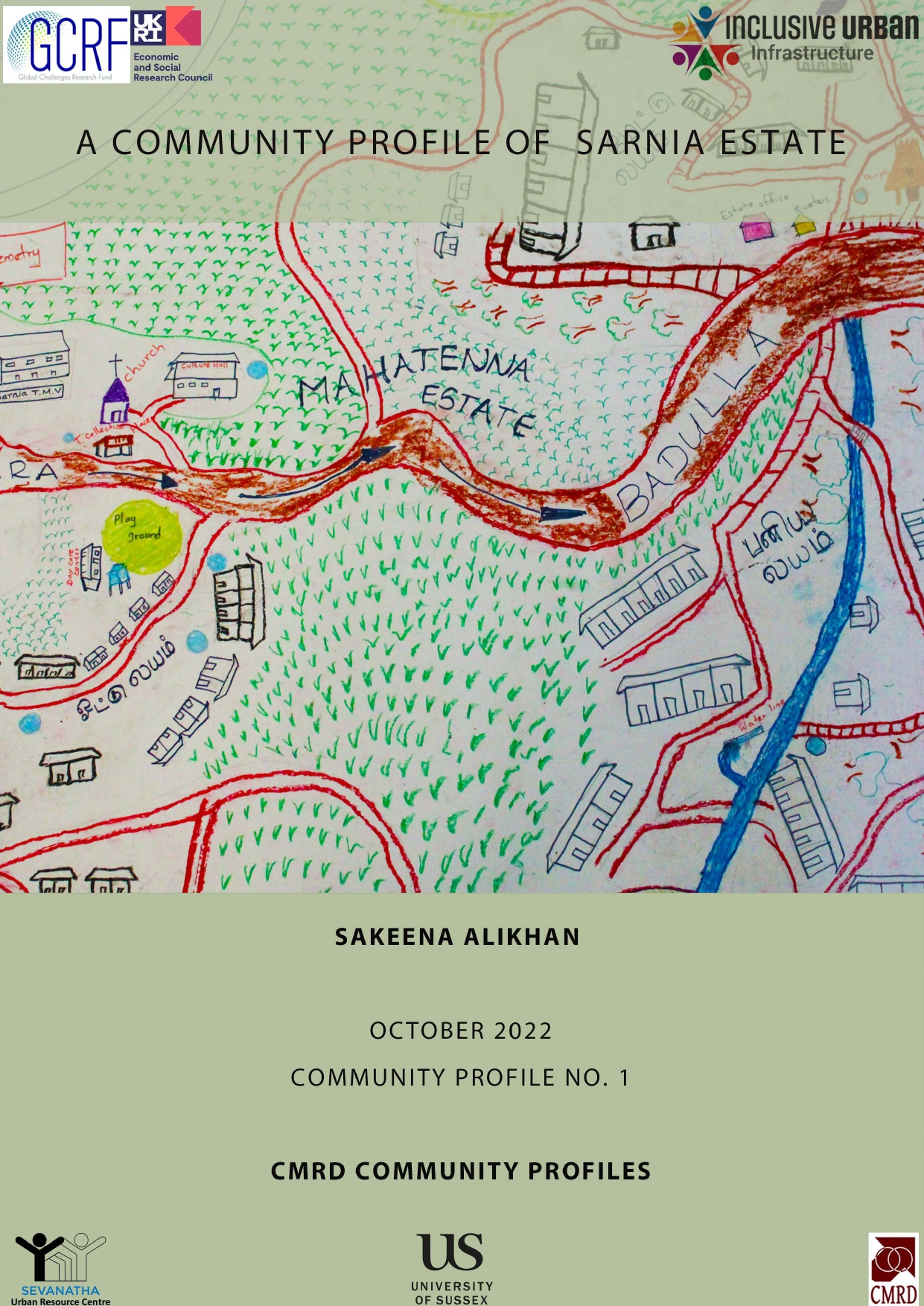 The Sarnia Estate owned by the Malwatte Valley Plantation PLC was established in 1885 in Badulla by a Scottish company that brought labourers from India. People still live in the ‘line’ houses constructed in the colonial period and have limited services. Besides the Indian migrants, a number of families from Galaha in Kandy were brought and settled in the estate by the management in 1978. Some of the families extended their houses with the remittances they receive from their family members who work in other cities, particularly Colombo. Nevertheless, the land and homes are still under the estate management and people do not have legal documents to claim ownership. The Sarnia Estate owned by the Malwatte Valley Plantation PLC was established in 1885 in Badulla by a Scottish company that brought labourers from India. People still live in the ‘line’ houses constructed in the colonial period and have limited services. Besides the Indian migrants, a number of families from Galaha in Kandy were brought and settled in the estate by the management in 1978. Some of the families extended their houses with the remittances they receive from their family members who work in other cities, particularly Colombo. Nevertheless, the land and homes are still under the estate management and people do not have legal documents to claim ownership.
(download the paper)
A Community Profile of Nawagampura
By: Sakeena Alikhan
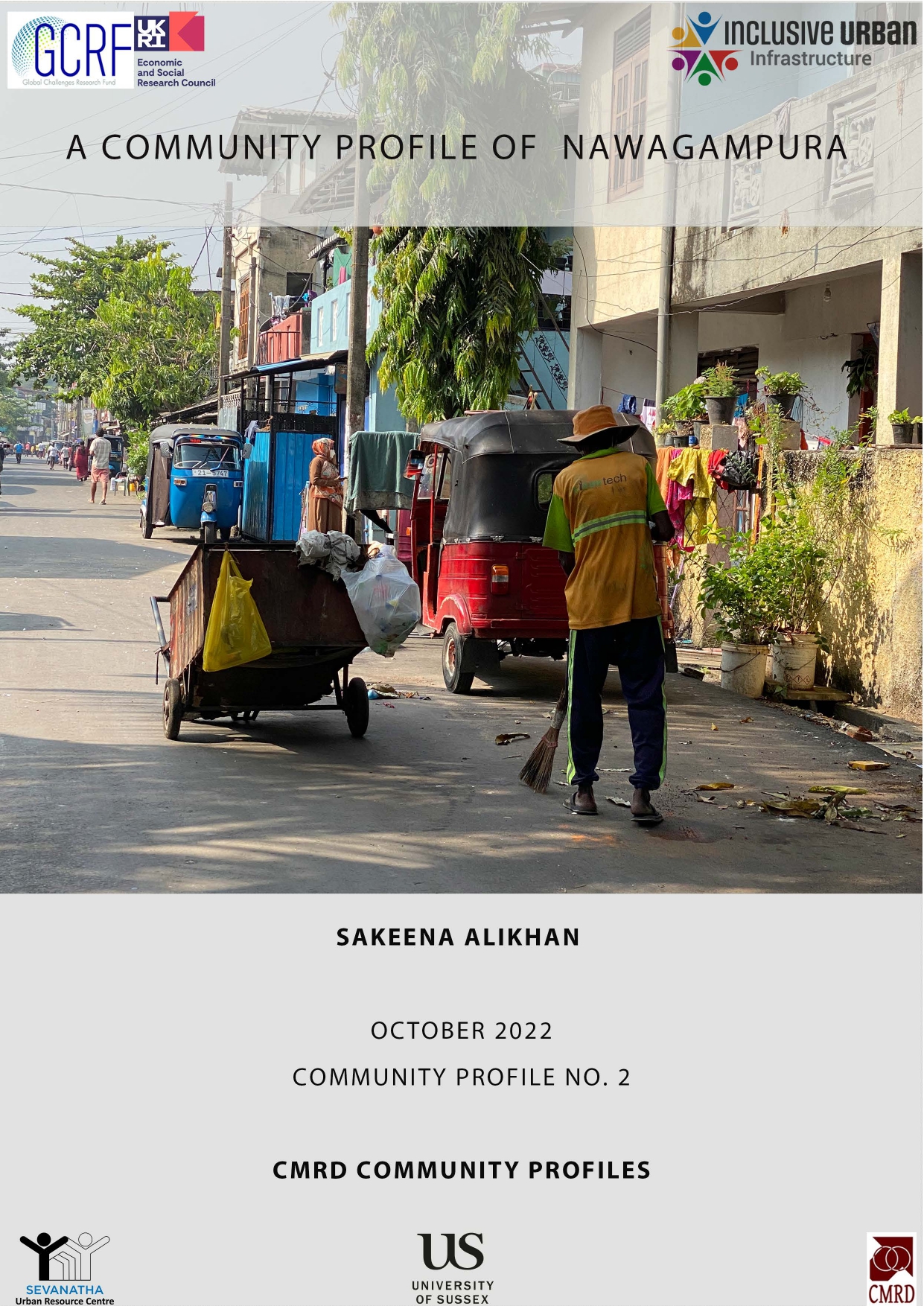 Nawagampura, which means "new town", is a new construction site with a "Sites and Services" approach in Colombo. The physical design for the new human settlement was prepared in 1982 at a training workshop for government planners conducted by the Massachusetts Institute of Technology (MIT) and sponsored by the National Housing Development Authority (NHDA) and the United States Agency for International Development (USAID). After the process, allottees were provided with a building plot of 2 perches and a loan for building the house. The loan was issued in several installments after the completion of certain stages of the building process. Nawagampura, which means "new town", is a new construction site with a "Sites and Services" approach in Colombo. The physical design for the new human settlement was prepared in 1982 at a training workshop for government planners conducted by the Massachusetts Institute of Technology (MIT) and sponsored by the National Housing Development Authority (NHDA) and the United States Agency for International Development (USAID). After the process, allottees were provided with a building plot of 2 perches and a loan for building the house. The loan was issued in several installments after the completion of certain stages of the building process.
(download the paper)
A Community Profile of Sammanthranapura
By: Sakeena Alikhan
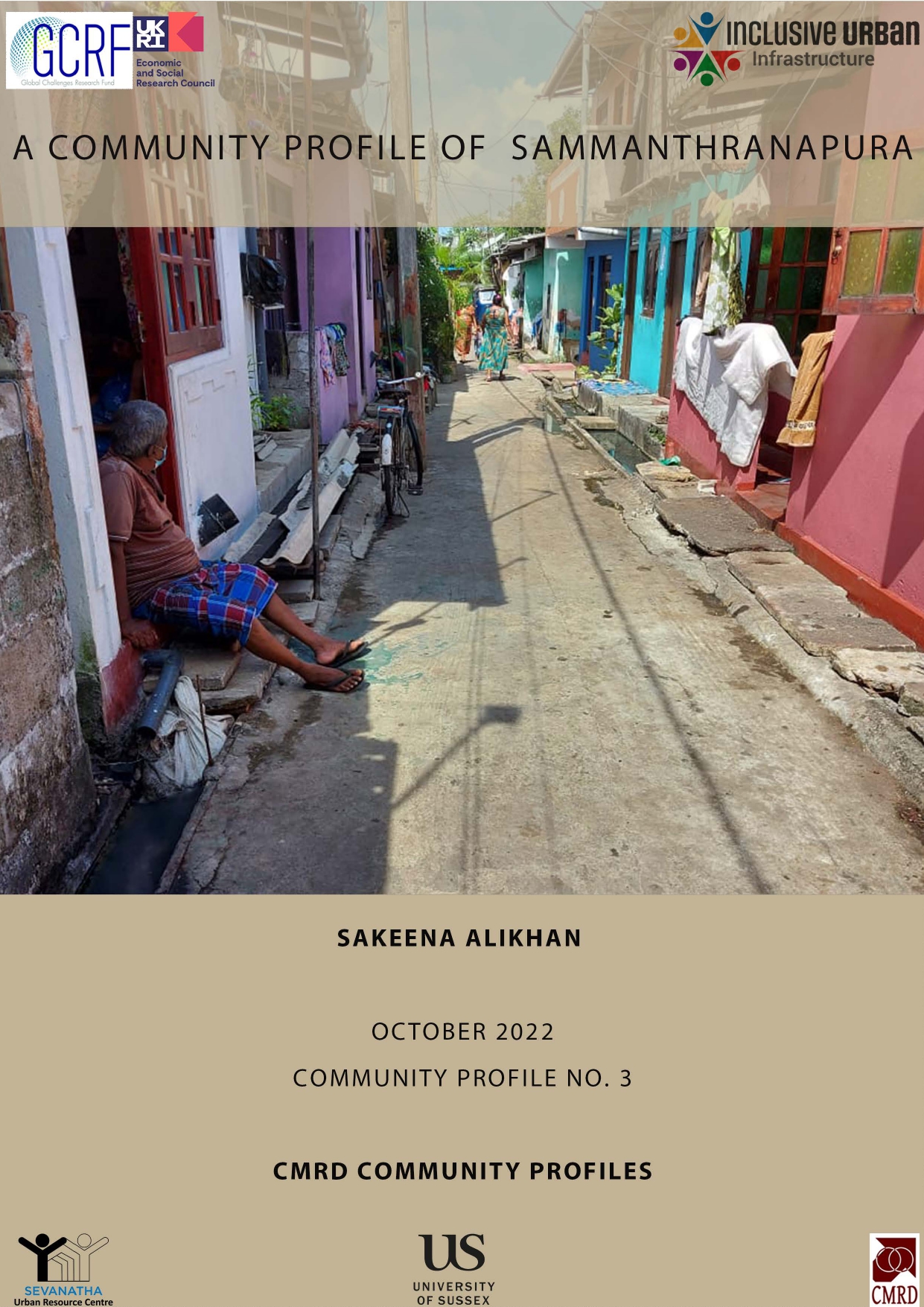 The Sammanthranapura settlement was established in 1976 as a result of evictions due to infrastructure development activities for the 5th Summit of the Non-Aligned Movement in Colombo. The residential dwellings are dispersed throughout the neighbourhood in four clusters: Gemunupura, Pichchamalwatta, Sri Wickramapura and Samithpura.There was no proper overall housing layout plan for the community. As a result, the majority of house structures vary depending on the cluster. For example, well-planned housing structures can be observed in the Sri Wickramapura but the buildings in Gemunupura are built largely of semi-permanent materials and in an unorganized manner. The Sammanthranapura settlement was established in 1976 as a result of evictions due to infrastructure development activities for the 5th Summit of the Non-Aligned Movement in Colombo. The residential dwellings are dispersed throughout the neighbourhood in four clusters: Gemunupura, Pichchamalwatta, Sri Wickramapura and Samithpura.There was no proper overall housing layout plan for the community. As a result, the majority of house structures vary depending on the cluster. For example, well-planned housing structures can be observed in the Sri Wickramapura but the buildings in Gemunupura are built largely of semi-permanent materials and in an unorganized manner.
(download the paper)
A Community Profile of Lunupokuna
By: Sakeena Alikhan
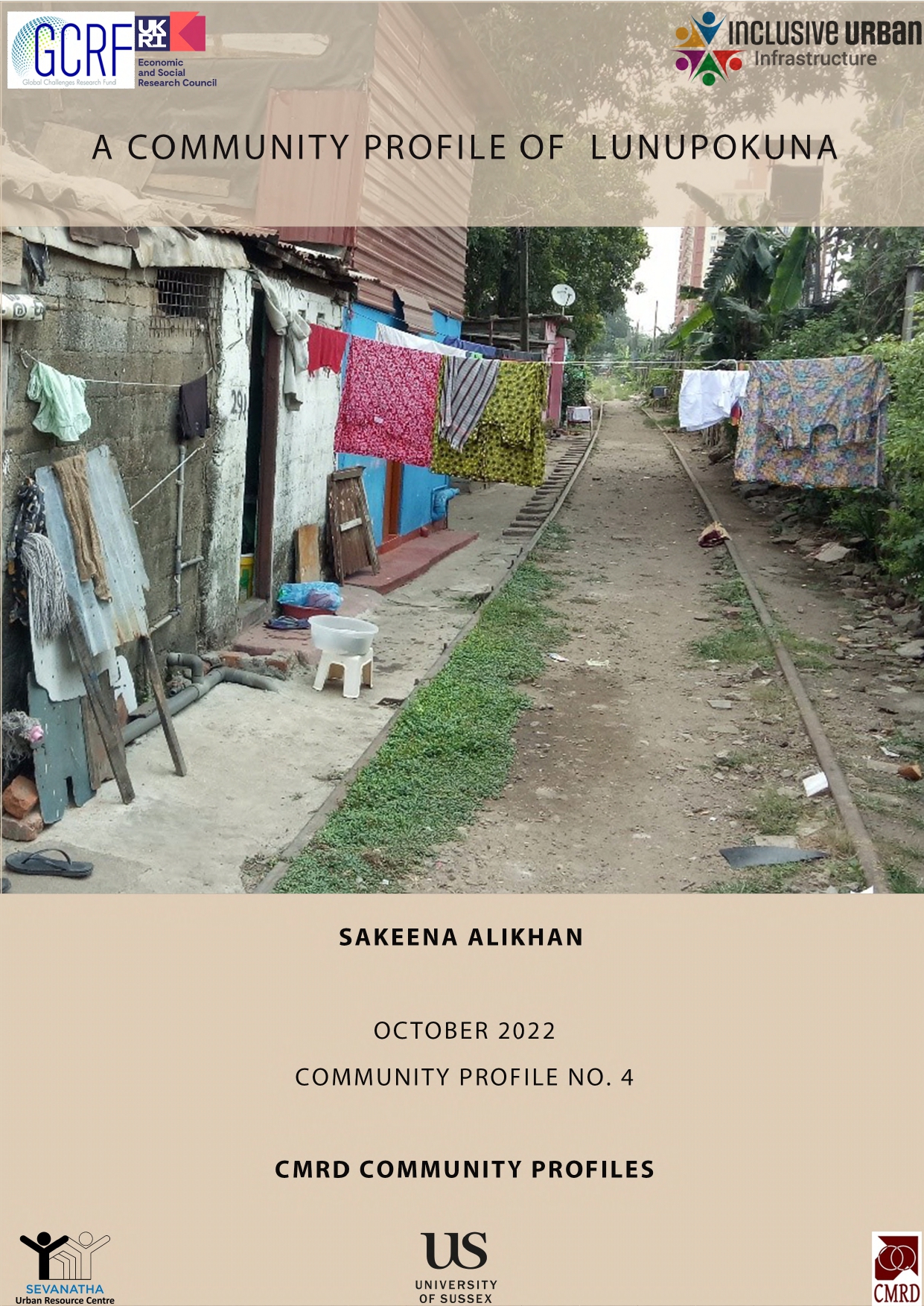 In the 1986s, residents of the community were relocated from the nearby squatter colony in Colombo. The settlers received a loan to build their homes in the 1 and 1/2 perches of land. The loan was provided by the National Housing Development Authority (NHDA). People changed their wooden homes to brick homes after securing the loan. The residents continue to make their loan payments to the NHDA every month. The type of housing and its design are influenced by the land’s characteristics, density, and the resident’s financial situation. Encroachers had built a significant number of wooden houses, most of which were situated close to an abandoned railroad track and a canal. In the 1986s, residents of the community were relocated from the nearby squatter colony in Colombo. The settlers received a loan to build their homes in the 1 and 1/2 perches of land. The loan was provided by the National Housing Development Authority (NHDA). People changed their wooden homes to brick homes after securing the loan. The residents continue to make their loan payments to the NHDA every month. The type of housing and its design are influenced by the land’s characteristics, density, and the resident’s financial situation. Encroachers had built a significant number of wooden houses, most of which were situated close to an abandoned railroad track and a canal.
(download the paper)
A Community Profile of Mahaiyawa
By: Sakeena Alikhan
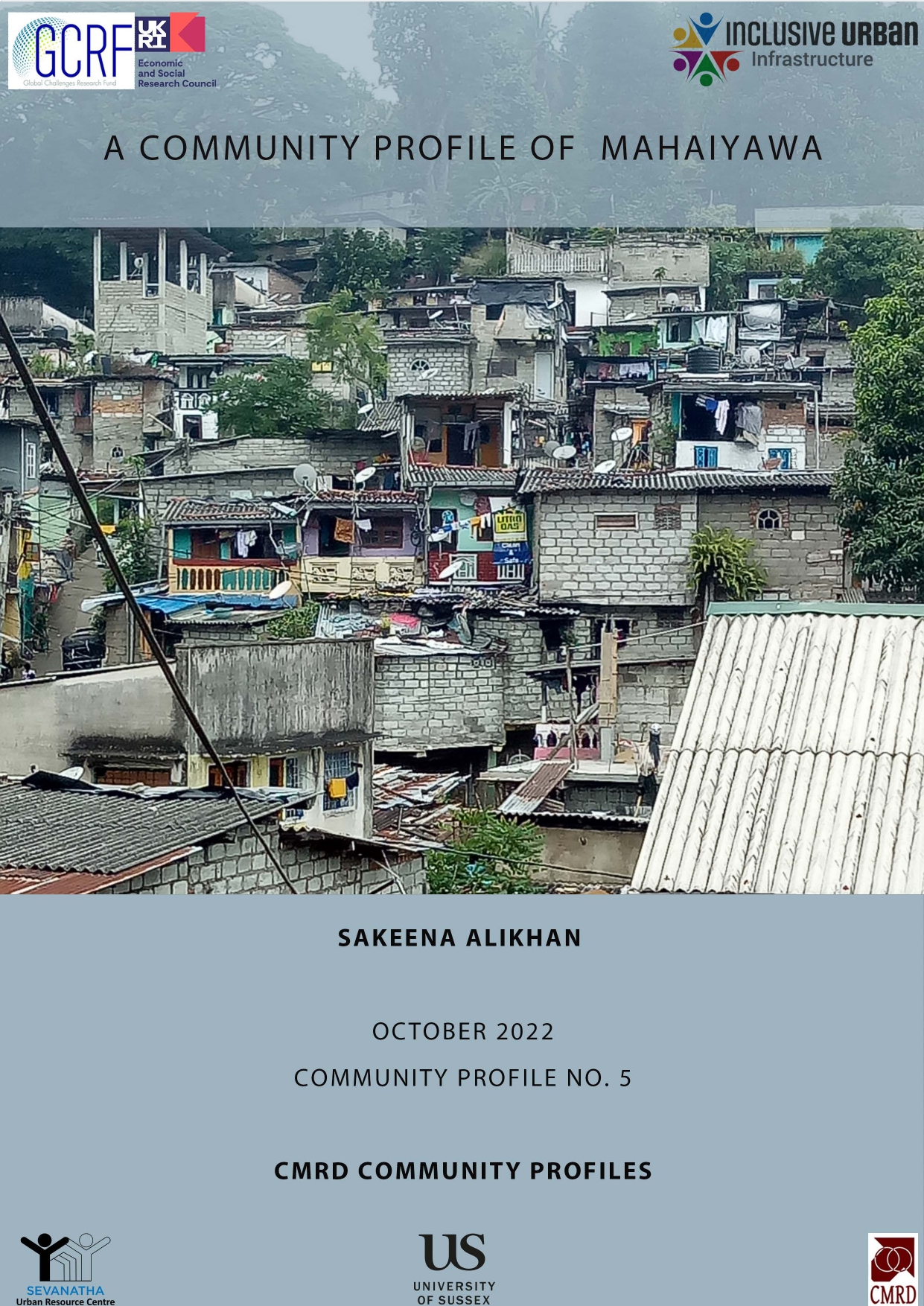 The Mahaiyawa settlement has its origins in the year 1865. The people mainly consist of the Kandy Municipal Council employees who worked as labourers, having been brought from South India by the British colonial government. They were responsible for the maintenance and cleanliness of the Kandy City. These people were eventually given some housing. This was row housing in the style of barracks, with single rooms and shared facilities. Individual shanties were later constructed by the residents themselves. These units lacked adequate lighting, ventilation, water supply, toilets, and drainage. What was available has also deteriorated over time due to overpopulation. The Mahaiyawa settlement has its origins in the year 1865. The people mainly consist of the Kandy Municipal Council employees who worked as labourers, having been brought from South India by the British colonial government. They were responsible for the maintenance and cleanliness of the Kandy City. These people were eventually given some housing. This was row housing in the style of barracks, with single rooms and shared facilities. Individual shanties were later constructed by the residents themselves. These units lacked adequate lighting, ventilation, water supply, toilets, and drainage. What was available has also deteriorated over time due to overpopulation.
(download the paper)
A Community Profile of Salamulla
By: Sakeena Alikhan
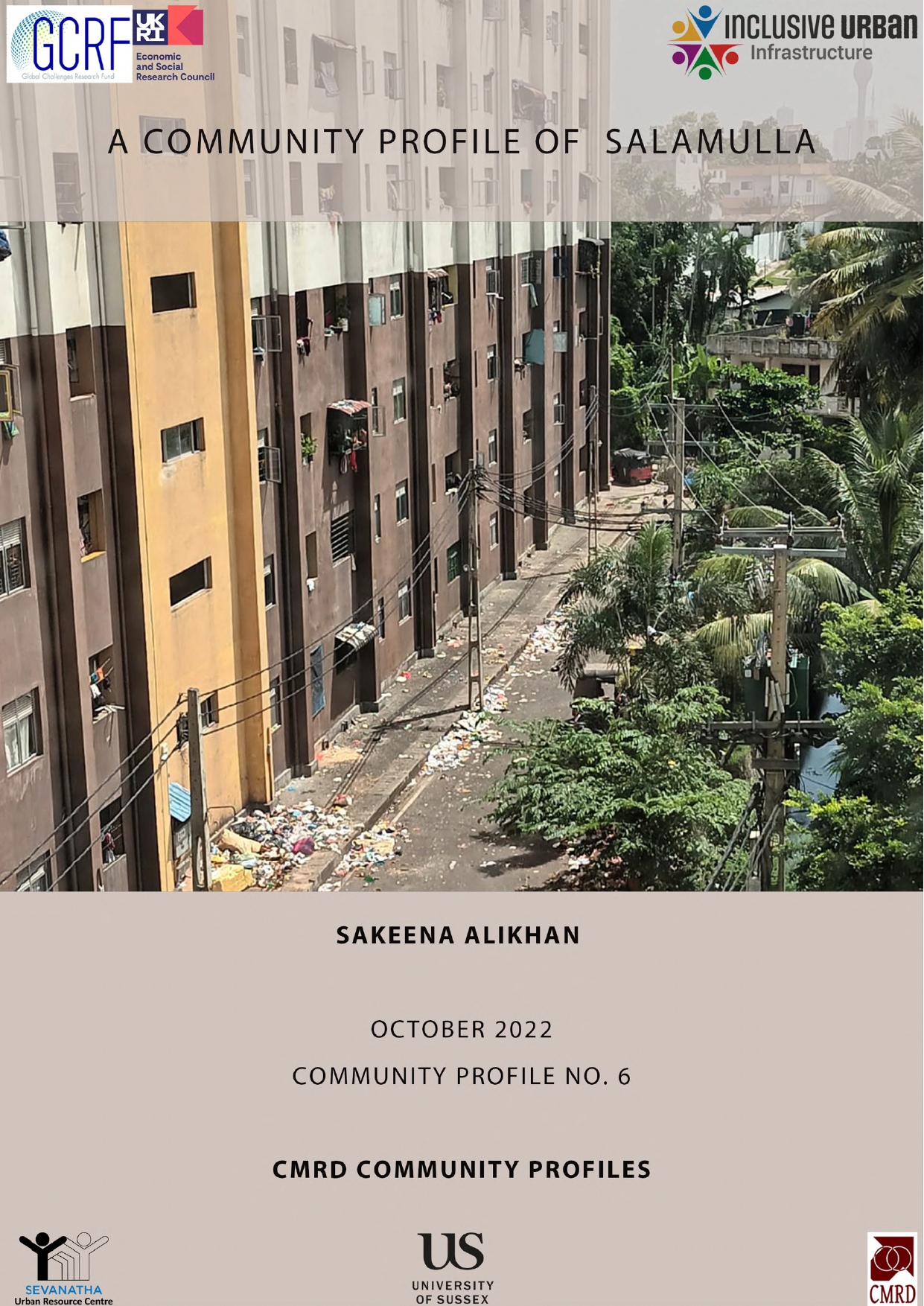 Occupying over 1.7 ha of land in Colombo, the construction on the Salamulla Laksanda Sevana highrise housing complex of 994 dwelling units began in 2011 and was completed and opened in 2017. Each unit of 450 square feet has a living area, two bedrooms, a kitchen, a balcony, and a bathroom. The housing project consists of blocks A, B, and C. Block A has a total of 216 dwelling units in its twelve floors, with 18 units on each floor. Blocks B and C have 33 residences on each floor and a total of 792 units over 12 floors. The residents of Salamulla came from several parts of Colombo City. For example, about 329 housing units were handed over to families affected by the Meethotamulla garbage dump collapse. Others include those from various Watta’s and selected projects sites. Occupying over 1.7 ha of land in Colombo, the construction on the Salamulla Laksanda Sevana highrise housing complex of 994 dwelling units began in 2011 and was completed and opened in 2017. Each unit of 450 square feet has a living area, two bedrooms, a kitchen, a balcony, and a bathroom. The housing project consists of blocks A, B, and C. Block A has a total of 216 dwelling units in its twelve floors, with 18 units on each floor. Blocks B and C have 33 residences on each floor and a total of 792 units over 12 floors. The residents of Salamulla came from several parts of Colombo City. For example, about 329 housing units were handed over to families affected by the Meethotamulla garbage dump collapse. Others include those from various Watta’s and selected projects sites.
(download the paper)
|

 The Sarnia Estate owned by the Malwatte Valley Plantation PLC was established in 1885 in Badulla by a Scottish company that brought labourers from India. People still live in the ‘line’ houses constructed in the colonial period and have limited services. Besides the Indian migrants, a number of families from Galaha in Kandy were brought and settled in the estate by the management in 1978. Some of the families extended their houses with the remittances they receive from their family members who work in other cities, particularly Colombo. Nevertheless, the land and homes are still under the estate management and people do not have legal documents to claim ownership.
The Sarnia Estate owned by the Malwatte Valley Plantation PLC was established in 1885 in Badulla by a Scottish company that brought labourers from India. People still live in the ‘line’ houses constructed in the colonial period and have limited services. Besides the Indian migrants, a number of families from Galaha in Kandy were brought and settled in the estate by the management in 1978. Some of the families extended their houses with the remittances they receive from their family members who work in other cities, particularly Colombo. Nevertheless, the land and homes are still under the estate management and people do not have legal documents to claim ownership. Nawagampura, which means "new town", is a new construction site with a "Sites and Services" approach in Colombo. The physical design for the new human settlement was prepared in 1982 at a training workshop for government planners conducted by the Massachusetts Institute of Technology (MIT) and sponsored by the National Housing Development Authority (NHDA) and the United States Agency for International Development (USAID). After the process, allottees were provided with a building plot of 2 perches and a loan for building the house. The loan was issued in several installments after the completion of certain stages of the building process.
Nawagampura, which means "new town", is a new construction site with a "Sites and Services" approach in Colombo. The physical design for the new human settlement was prepared in 1982 at a training workshop for government planners conducted by the Massachusetts Institute of Technology (MIT) and sponsored by the National Housing Development Authority (NHDA) and the United States Agency for International Development (USAID). After the process, allottees were provided with a building plot of 2 perches and a loan for building the house. The loan was issued in several installments after the completion of certain stages of the building process. The Sammanthranapura settlement was established in 1976 as a result of evictions due to infrastructure development activities for the 5th Summit of the Non-Aligned Movement in Colombo. The residential dwellings are dispersed throughout the neighbourhood in four clusters: Gemunupura, Pichchamalwatta, Sri Wickramapura and Samithpura.There was no proper overall housing layout plan for the community. As a result, the majority of house structures vary depending on the cluster. For example, well-planned housing structures can be observed in the Sri Wickramapura but the buildings in Gemunupura are built largely of semi-permanent materials and in an unorganized manner.
The Sammanthranapura settlement was established in 1976 as a result of evictions due to infrastructure development activities for the 5th Summit of the Non-Aligned Movement in Colombo. The residential dwellings are dispersed throughout the neighbourhood in four clusters: Gemunupura, Pichchamalwatta, Sri Wickramapura and Samithpura.There was no proper overall housing layout plan for the community. As a result, the majority of house structures vary depending on the cluster. For example, well-planned housing structures can be observed in the Sri Wickramapura but the buildings in Gemunupura are built largely of semi-permanent materials and in an unorganized manner. In the 1986s, residents of the community were relocated from the nearby squatter colony in Colombo. The settlers received a loan to build their homes in the 1 and 1/2 perches of land. The loan was provided by the National Housing Development Authority (NHDA). People changed their wooden homes to brick homes after securing the loan. The residents continue to make their loan payments to the NHDA every month. The type of housing and its design are influenced by the land’s characteristics, density, and the resident’s financial situation. Encroachers had built a significant number of wooden houses, most of which were situated close to an abandoned railroad track and a canal.
In the 1986s, residents of the community were relocated from the nearby squatter colony in Colombo. The settlers received a loan to build their homes in the 1 and 1/2 perches of land. The loan was provided by the National Housing Development Authority (NHDA). People changed their wooden homes to brick homes after securing the loan. The residents continue to make their loan payments to the NHDA every month. The type of housing and its design are influenced by the land’s characteristics, density, and the resident’s financial situation. Encroachers had built a significant number of wooden houses, most of which were situated close to an abandoned railroad track and a canal. The Mahaiyawa settlement has its origins in the year 1865. The people mainly consist of the Kandy Municipal Council employees who worked as labourers, having been brought from South India by the British colonial government. They were responsible for the maintenance and cleanliness of the Kandy City. These people were eventually given some housing. This was row housing in the style of barracks, with single rooms and shared facilities. Individual shanties were later constructed by the residents themselves. These units lacked adequate lighting, ventilation, water supply, toilets, and drainage. What was available has also deteriorated over time due to overpopulation.
The Mahaiyawa settlement has its origins in the year 1865. The people mainly consist of the Kandy Municipal Council employees who worked as labourers, having been brought from South India by the British colonial government. They were responsible for the maintenance and cleanliness of the Kandy City. These people were eventually given some housing. This was row housing in the style of barracks, with single rooms and shared facilities. Individual shanties were later constructed by the residents themselves. These units lacked adequate lighting, ventilation, water supply, toilets, and drainage. What was available has also deteriorated over time due to overpopulation. Occupying over 1.7 ha of land in Colombo, the construction on the Salamulla Laksanda Sevana highrise housing complex of 994 dwelling units began in 2011 and was completed and opened in 2017. Each unit of 450 square feet has a living area, two bedrooms, a kitchen, a balcony, and a bathroom. The housing project consists of blocks A, B, and C. Block A has a total of 216 dwelling units in its twelve floors, with 18 units on each floor. Blocks B and C have 33 residences on each floor and a total of 792 units over 12 floors. The residents of Salamulla came from several parts of Colombo City. For example, about 329 housing units were handed over to families affected by the Meethotamulla garbage dump collapse. Others include those from various Watta’s and selected projects sites.
Occupying over 1.7 ha of land in Colombo, the construction on the Salamulla Laksanda Sevana highrise housing complex of 994 dwelling units began in 2011 and was completed and opened in 2017. Each unit of 450 square feet has a living area, two bedrooms, a kitchen, a balcony, and a bathroom. The housing project consists of blocks A, B, and C. Block A has a total of 216 dwelling units in its twelve floors, with 18 units on each floor. Blocks B and C have 33 residences on each floor and a total of 792 units over 12 floors. The residents of Salamulla came from several parts of Colombo City. For example, about 329 housing units were handed over to families affected by the Meethotamulla garbage dump collapse. Others include those from various Watta’s and selected projects sites.

